Orange Mousse Cake
by Editorial Staff
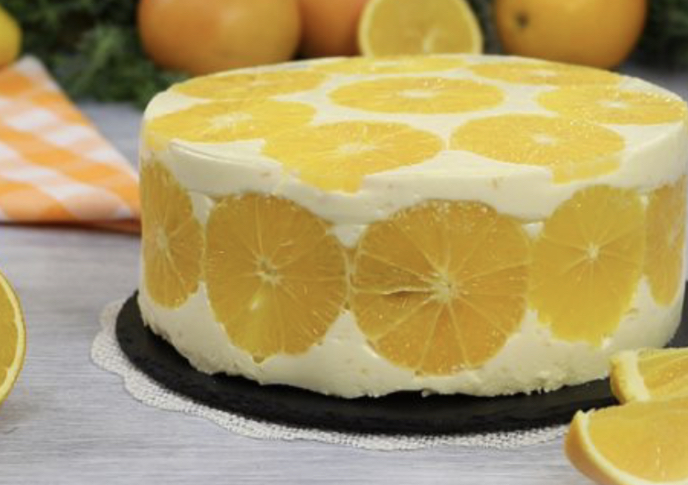
I would like to share with you an excellent refreshing orange mousse cake. The cake contains a juicy biscuit, thanks to the impregnation with orange juice, a layer of orange confit between the cakes, and simply incredibly tasty and fragrant orange mousse. The cake turns out to be delicate, with a pronounced orange aroma and a very effective appearance. This cake can easily be called “Orange with orange in orange”.
 Ingredients
Ingredients
For a biscuit:
- Category C1 eggs – 5 pcs. (room temperature ° С)
- Flour – 140 g
- Sugar – 150 g
- Baking powder – 1 teaspoon
- Corn starch – 30 g
- Vanilla sugar – 10 g
- Salt – 1 pinch
- Orange – 1-2 pcs. (medium size)
- Lemon juice or vinegar – for greasing the bowl
For the orange confit:
- Oranges – 3 pcs. (medium size)
- Gelatin – 10 g
- Water (cold) – 60 ml
- Sugar – 75 g
For the orange mousse:
- Oranges – 3 pcs. (medium size)
- Cream 33-35% (cold) – 600 ml
- Gelatin – 12 g
- Water (cold) – 75 ml
- Egg yolks – 5 pcs.
- Sugar – 225 g
- Corn starch – 30 g
For filling:
- Fresh oranges (medium) – 3-4 pcs.
Directions
- All foods should be at room temperature.
We turn on the oven and heat it to 180 degrees.
Rub 1 teaspoon of zest on a fine grater (only the orange part).
In a bowl, combine flour, baking powder, and cornstarch. - Sift the mixture of dry ingredients through a sieve, then mix well with a whisk and set aside.
- We divide the eggs into whites and yolks. Beat egg yolks (room temperature) in a large bowl for literally half a minute.
- Add half the sugar, vanilla sugar, and orange zest to the yolks.
- Beat the yolk mixture on medium mixer speed until light and fluffy, about 3-4 minutes.
- Degrease a clean bowl with lemon juice or vinegar. In it, beat the egg whites (room temperature) with salt and the rest of the sugar at a medium mixer speed.
- We introduce sugar gradually. The first time we add sugar when the whites are beaten until a light foam state.
- Add a second time when the foam becomes more stable.
- Add the third time when the mass turns white.
Beat the whites until soft peaks, when the “tail” hangs from the whisk of the mixer but does not fall off. - Add 2/3 of the whipped egg whites to the yolk mass in several steps and mix very gently with a spatula in folding movements from bottom to top, until the products are combined.
Do not stir for a long time, otherwise, the egg mass will settle and will not be so airy. - Sift the mixture of dry ingredients into the egg mass in parts. Mix well with a spatula, also folding from bottom to top, until the products are combined.
- At the very end, add the remaining egg whites to the dough and quickly, but very gently, mix until smooth.
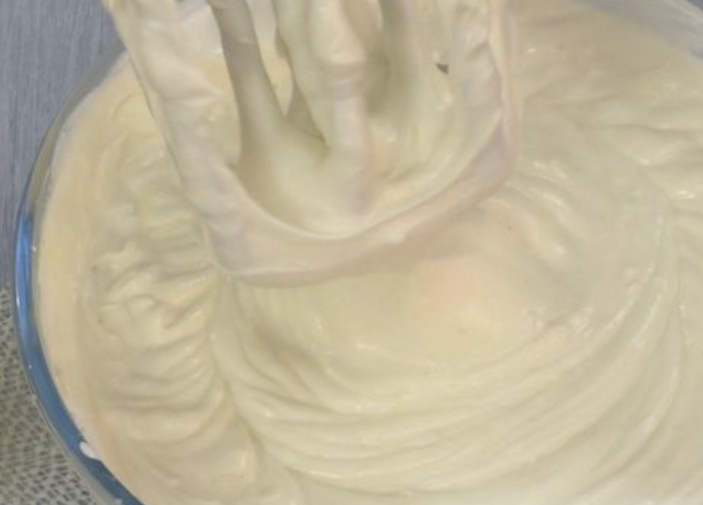
- Take two detachable round shapes (18 cm in diameter) and tighten the bottom with foil. We layout the biscuit dough in forms and evenly distribute it over the entire surface.
- We bake biscuit cakes in an oven preheated to 180 ° C for about 25-30 minutes. We check the readiness of the biscuits with a wooden skewer inserted in the center – it should come out completely dry.
- Remove the biscuit cakes from the oven and leave them on the table in the form for 10 minutes.
- Then we carefully draw a thin knife along the walls of each form and remove the cakes.
- The biscuits are light, airy, fragrant, with a slight orange hint.
- Leave the still warm cakes on the wire rack until they cool completely.
- Cooking orange confit. Pour gelatin with cold water, mix well and leave for 10-15 minutes to swell.
- Rinse fresh oranges well under running water. Rub on a fine grater 1 tablespoon. a spoonful of zest (only the orange part). We peel the oranges from the peel and white film.
- Cut the peeled oranges into small pieces.
- Transfer the chopped oranges to the blender bowl and punch until smooth. You get about 400 g of orange puree (I have 380 g).
- In a saucepan, combine orange puree, sugar, and orange zest.
We put the saucepan over medium heat and, stirring constantly, cook until the sugar is completely dissolved. Bring the mixture to a boil and cook for another 1 minute. - Remove the stewpan from the stove and cool the confit to 60 degrees. Add the swollen gelatin to the slightly cooled orange confit and stir until it is completely dissolved.
Then let the orange confit cool a little more at room temperature. - Take two round shapes (with a diameter of 18 cm) and tighten the bottom with cling film. Pour the cooled orange confit into molds. We put the blanks in the freezer for 2-3 hours.
- Cooking orange mousse. Pour gelatin with cold water, mix well and leave for 10-15 minutes to swell.
Squeeze 400 ml of juice from oranges. We run on a fine grater 1 tablespoon. a spoonful of zest (only the orange part). - Combine egg yolks, sugar, cornstarch, orange zest, and freshly squeezed orange juice in a saucepan.
- Mix well with a whisk until smooth without lumps.
- We put the saucepan on low heat and cook the orange curd with constant stirring until the mixture thickens.
- Remove the saucepan with orange cream from the heat, add the swollen gelatin and mix well until the gelatin is completely dissolved.
- Pour the orange cream into a clean bowl. We cover with cling film so that the film lies directly on the surface of the cream. Then we cool to room temperature.
- In another large bowl, beat the cold cream until soft peaks.
- Add the cooled custard orange curd to the whipped cream in parts and beat at a low mixer speed until smooth.
- We do not put the finished mousse in the refrigerator so that it does not freeze. We just leave it on the table at room temperature.
- Preparing the filling for the cake. Rinse fresh oranges well under running water and peel them. When peeling the peels of the oranges, we also try to remove the white fibers and film from the fruit pulp, otherwise, the oranges will taste bitter in the cake later.
Cut the peeled oranges into thin slices about 5-7 mm thick. - Let’s start assembling the cake. Tighten the bottom of the confectionery ring (22 cm in diameter) with cling film. We lay the sides of the form with an acetate film.
We will collect the cake upside down. That is, the bottom of the cake will be its top.
To impregnate the biscuit cakes, squeeze 120 ml of juice out of the oranges. - Place the sliced orange circles on the bottom of the mold. We try to choose the most beautiful orange slices, as they will be the decoration and “face” of the cake.
- Divide the orange mousse into four equal parts. Put 1/4 of the mousse on the bottom of the mold and distribute it evenly over the entire surface.
- We remove the form in the freezer for 5 minutes so that the mousse grabs, fixes the fruit slices, and also so that the filling does not sink in it.
- After the specified time, we take out the cake from the freezer. We spread the remaining orange circles close to the entire peri of the side of the form. We try to choose orange slices of approximately the same size.
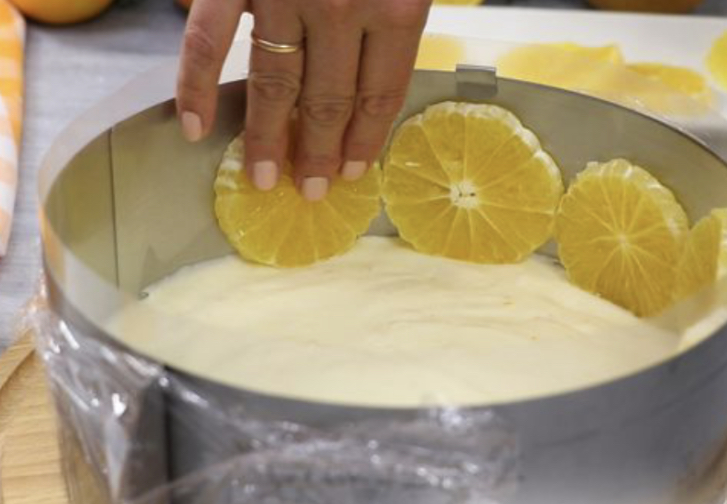
- We take out the frozen orange confit from the freezer and put it on top of the mousse right in the center of the cake.
- Spread another 1/4 of the orange mousse on top of the confit and distribute evenly.
- For biscuit cakes, cut off the baked top and trim it a little.
- Then, on top of the mousse, layout the first biscuit cake with a cut up and sink it quite a bit. Saturate the biscuit with freshly squeezed orange juice over the entire surface and along the edges of the cake.
- Pour another 1/4 part of the orange mousse on top of the biscuit, smooth it well over the entire surface of the cake.
- We take out the second frozen disc of orange confit from the freezer and place it on top of the mousse in the center of the cake.
- On top of the orange confit, spread the remaining orange mousse and smooth well.
- Soak a slice of the second biscuit cake well with orange juice over the entire surface and along the edges of the cake.
Then, on top of the mousse, layout the biscuit cake soaked in juice with the cut-down and sink a little. - Cover the cake mold with cling film and put it in the refrigerator for 4-5 hours or until it hardens completely.
- After the specified time, we take out the frozen cake from the refrigerator. We remove the cling film, carefully walk with a thin knife along the edge of the acetate film. Remove the detachable form and very carefully remove the acetate film.
- Place a suitable serving dish on top of the cake and turn it upside down. At the same time, we firmly hold the dish with one hand, and the base with the other hand. Thus, we have a biscuit with the base of the cake, and the orange circles – with a beautiful top.
- Carefully remove the cling film from the top of the cake.
- Mousse cake with oranges is ready.
- Cut the cake into portions. We brew tea and enjoy an incredibly tasty, airy, and very aromatic orange cake.
Lovers of citrus baked goods will surely appreciate this dessert!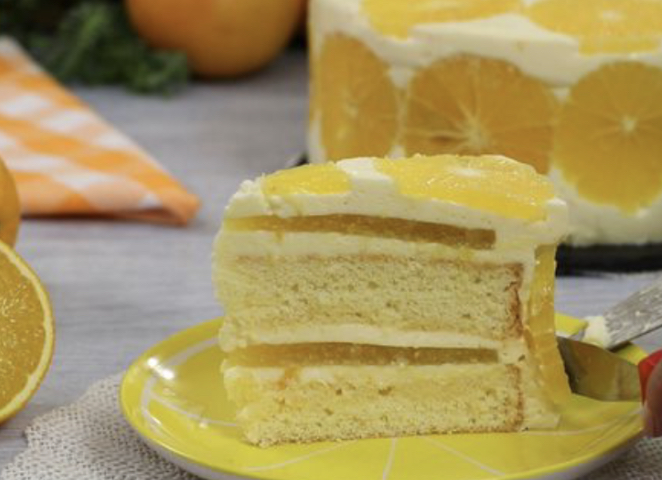
Enjoy your meal!
 Also Like
Also Like

The mousse turns out to be light in all respects. Delicious dessert. Cook: 40 minutes Servings: 4 Ingredients Small lemons – 2 pcs. Orange – 1 pc. Water – 500 g Semolina – 5 tbsp Sugar – 5 tbsp Directions Boil semolina in water with lemon juice and sugar ...

The perfect avocado – orange – mousse recipe with a picture and simple step-by-step instructions. More...

The perfect salted orange mousse recipe with a picture and simple step-by-step instructions. More...

The perfect orange and ginger mousse recipe with a picture and simple step-by-step instructions. More...

The perfect orange and marzipan mousse recipe with a picture and simple step-by-step instructions. More...

The perfect yogurt mousse with oranges recipe with a picture and simple step-by-step instructions. More...

Chocolate Cream Mousse with Oranges
Chocolate cream mousse is made from crushed dark chocolate with the addition of orange and sour cream. Cook: 10 minutes Servings: 4 Ingredients Orange – 1 pc. Black chocolate (broken into pieces) – 120 g Butter – 2 tbsp Maple syrup – 3 tbsp Orange liqueur...

Chocolate Mousse with Orange Scent
The perfect chocolate mousse with orange scent recipe with a picture and simple step-by-step instructions. More...

Espresso Mousse with Orange Salad
The perfect espresso mousse with orange salad recipe with a picture and simple step-by-step instructions. More...

Chestnut Mousse with Orange Jelly
The perfect chestnut mousse with orange jelly recipe with a picture and simple step-by-step instructions. More...
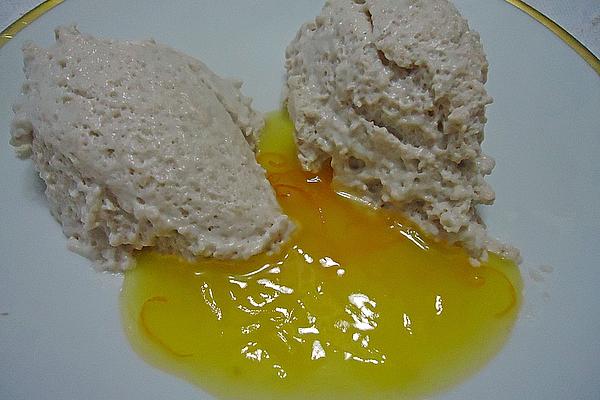
Guava Mousse with Orange Sauce
The perfect guava mousse with orange sauce recipe with a picture and simple step-by-step instructions. More...

Marzipan Mousse with Spicy Oranges
The perfect marzipan mousse with spicy oranges recipe with a picture and simple step-by-step instructions. More...

Orange Mousse with Tangerines and Kiwi
The perfect orange mousse with tangerines and kiwi recipe with a picture and simple step-by-step instructions. More...

The perfect orange mousse without cream recipe with a picture and simple step-by-step instructions. More...

Vanilla Curd Mousse with Oranges
The perfect vanilla curd mousse with oranges recipe with a picture and simple step-by-step instructions. More...

Spicy Oranges on Cinnamon Mousse
The perfect spicy oranges on cinnamon mousse recipe with a picture and simple step-by-step instructions. More...
Comments for "Orange Mousse Cake"
 |
 |
 |
 |
Get FREE Recipe Gifts now. Or latest free cooktops from our best collections.
Disable Ad block to get all the secrets. Once done, hit any button below
 |
 |
 |
 |



